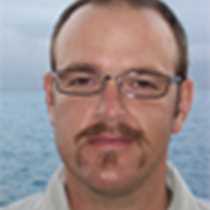Santiago Island
We arrived at our next island early and were presented a success story in conservation. Santiago has had a long history of exploration and human settlement dating back to the late 1700’s and with it the introduction of invasive species such as feral goats and pigs. Today we find Santiago a lush and vibrant island with its biodiversity intact after various conservation labors from visitors and the local population’s efforts.
Espumilla Beach is the landing site where we encounter a long pristine beach with a great amount of Pacific green sea turtle nests among the roots of massive mangroves. Our trail leads us inland to a shallow brackish pond, which is teeming with ghost and fiddler crabs along the outer perimeter. After the El Niño flooding of 1982-83, a small flamingo population that visited this brackish pond has deserted the area, but this is the way of nature, ebb and flow and life continues in its abundance.
Darwin finches give us a soundtrack on our hike up to an overlooking ridge with a view of our anchorage. Massive incense trees surround us and we note the incredible odor from this cousin of frankincense, and we find a Galápagos Hawk perched on a branch. Chatter ensues between the hawk and a distant sibling or parent, and we take in the character of this special site. Galápagos butterflies quickly move from our path as we move through the dense vegetation and enter a forest of gigantic mangroves that block out the sunlight as we maneuver among the tree trunks. We return to our home, the National Geographic Islander for a hearty breakfast then on to our mid-morning activities at Buccaneers Cove. Large pinnacles formed from ancient lava flows are topped with Opuntia prickly pears are seen as we snorkel and take a Zodiac ride along the coast. As we close this morning some witness a Galápagos Hawk attacking a Brown Noddy with the Noddy gaining freedom through it erratic flight. The struggle for life continues and we move on.
Puerto Egas is our destination in the afternoon, which is just a short navigation from our morning site. The human history is present as we see remnants of the salt mining operation that was here up until the 1960’s. Darwin was also a visitor to this island, and we have learned much from his observations and collections and much more as we walk in his footsteps. Lava lizards are out in droves as they use the exposed trail for sunning and demonstrating their attributes to the occasional passerby of the opposite gender. Upon arrival to the outer coast Galápagos fur seals are also sunning themselves on the basalt flows that enter the sea. Lava tubes with collapsed roofs give us a view of greenish pools with suspended bridges, which we can walk over. Plovers, Whimbrals, Oystercatchers, Ruddy Turnstones, and a Great Blue Heron move along the coastal area with determined direction and vigor as they continue on their paths just as we do until our return to our landing beach. Sally Lightfoot crabs and marine iguanas huddle on the highest coastal rocks as the high tide comes to its apex. The sun drops quickly and we return to our floating home with a renewed lease on life as we try to take in our day in all of its immensity.




